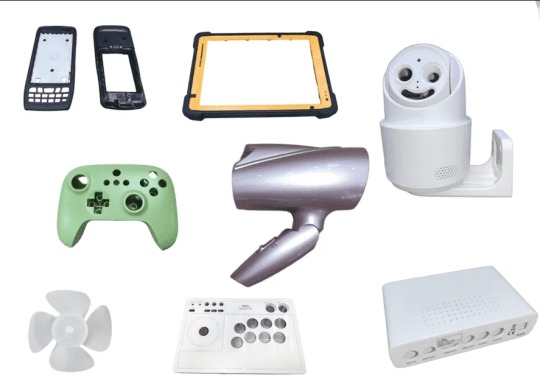Don't wanna be here? Send us removal request.
Text
Custom Plastic Parts: The Ultimate Guide to Design, Manufacturing, and Applications

In today’s manufacturing landscape, custom plastic parts play a crucial role in various industries, from automotive to medical devices. These components offer versatility, durability, and cost-effectiveness, making them a preferred choice for engineers and designers. This guide explores the design considerations, manufacturing processes, and applications of custom plastic parts, providing valuable insights for businesses and manufacturers.
What Are Custom Plastic Parts?
Custom plastic parts are specialized components designed and fabricated to meet specific functional and aesthetic requirements. Unlike standard off-the-shelf parts, these are tailored to fit unique applications, ensuring optimal performance. Manufacturers use advanced techniques like injection molding, 3D printing, and CNC machining to produce high-precision custom plastic parts with tight tolerances.
Benefits of Using Custom Plastic Parts
Design Flexibility – Engineers can create complex geometries that would be difficult or impossible with metals or other materials.
Cost-Effectiveness – Mass production of custom plastic parts reduces per-unit costs, especially for high-volume orders.
Lightweight & Durable – Plastics offer excellent strength-to-weight ratios, making them ideal for industries like aerospace and automotive.
Corrosion Resistance – Unlike metals, plastics resist rust and chemical degradation, extending product lifespan.
Customization Options – Colors, textures, and material properties can be adjusted to meet branding or functional needs.
Key Manufacturing Processes for Custom Plastic Parts
1. Injection Molding
Injection molding is the most common method for producing custom plastic parts in large quantities. Molten plastic is injected into a mold cavity, cooled, and ejected as a solid part. This process is ideal for high-volume production due to its speed and repeatability.
2. 3D Printing (Additive Manufacturing)
For prototyping or low-volume production, 3D printing allows rapid fabrication of custom plastic parts without expensive tooling. Technologies like FDM, SLA, and SLS enable intricate designs with minimal material waste.
3. CNC Machining
CNC machining is used for precision custom plastic parts requiring tight tolerances. This subtractive process involves cutting plastic blocks into desired shapes using computer-controlled tools.
4. Thermoforming
Thermoforming involves heating plastic sheets and forming them over molds. It’s commonly used for packaging, automotive interiors, and consumer products.
5. Rotational Molding
This method is ideal for large, hollow custom plastic parts like tanks and containers. A mold is rotated while heated plastic coats the interior, creating uniform wall thickness.
Material Selection for Custom Plastic Parts
Choosing the right plastic material is critical for performance and longevity. Common options include:
ABS – Tough, impact-resistant, and ideal for automotive and consumer goods.
Polycarbonate (PC) – High strength and transparency, used in medical devices and lenses.
Nylon (PA) – Excellent wear resistance, suitable for gears and bearings.
Polyethylene (PE) – Chemical-resistant and lightweight, often used in packaging.
Polypropylene (PP) – Flexible and fatigue-resistant, common in living hinges and containers.
Design Considerations for Custom Plastic Parts
To ensure optimal functionality and manufacturability, engineers must consider:
Wall Thickness – Uniform walls prevent warping and sink marks.
Draft Angles – Slight tapers ease part ejection from molds.
Ribs & Gussets – These reinforcements enhance strength without adding bulk.
Tolerances – Tight tolerances may require secondary machining.
Surface Finish – Textures or polished finishes impact aesthetics and performance.
Applications of Custom Plastic Parts
1. Automotive Industry
From interior trim to engine components, custom plastic parts reduce vehicle weight while maintaining durability.
2. Medical Devices
Plastics like PEEK and PVC are biocompatible, making them ideal for surgical instruments and implants.
3. Consumer Electronics
Housings, buttons, and connectors rely on custom plastic parts for sleek designs and functionality.
4. Aerospace & Defense
Lightweight plastics improve fuel efficiency in aircraft components while meeting strict safety standards.
5. Industrial Equipment
Gears, housings, and conveyor parts made from engineered plastics withstand harsh environments.
Choosing the Right Manufacturer for Custom Plastic Parts
When selecting a supplier, consider:
Experience & Expertise – Look for manufacturers with a proven track record in your industry.
Quality Standards – Certifications like ISO 9001 ensure consistent quality.
Prototyping Capabilities – Rapid prototyping helps validate designs before mass production.
Cost & Lead Time – Balance affordability with production speed.
Future Trends in Custom Plastic Parts Manufacturing
Sustainable Materials – Biodegradable and recycled plastics are gaining traction.
Smart Plastics – Embedded sensors and conductive polymers enable IoT integration.
Advanced 3D Printing – New materials and faster printing methods expand possibilities.
1 note
·
View note